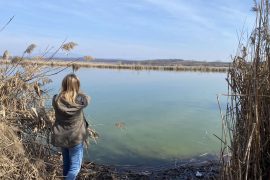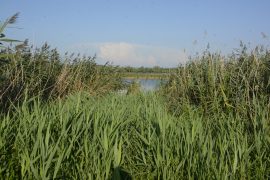A wind energy business aiming to implement a 1.5 GW project in the highlands of the Ukrainian Carpathians, along with an energy project announced by the company “Hydrogen of Ukraine” in Zakarpattia region, could be components of one large-scale initiative to supply European Union countries with green hydrogen.
The first mention in the media of green hydrogen production in Ukraine for supply to the European Union appeared in 2021. According to the European Green Deal, by 2030, Ukraine was expected to have 8,000 MW of electrolyzer capacity for green hydrogen and 1,800 MW for ammonia. To build such capacity it was projected to require investments totaling €20.1 billion.
Four regions were selected for the production and transportation of green hydrogen: Zaporizhzhia, Kherson, Dnipropetrovsk, and Odesa. According to the Renewable Energy Institute of the National Academy of Sciences of Ukraine, these are the regions with the highest potential for green hydrogen production in the country. This makes sense, as green hydrogen is primarily produced where there is an excess of renewable power. Exactly these regions have the greatest potential for the development of wind (WPP) and solar (SPP) power plants.
After russian occupation of parts of the Zaporizhzhia and Kherson regions, focus of green hydrogen development shifted – along with Odesa, where the first pilot project has already begun (a 120 MW solar power plant, 80 MW wind power plant, and a 100 MW electrolyzer installation) – to Zakarpattia, unexpectedly.
Zakarpattia is a region that, according to experts from the same Renewable Energy Institute of the National Academy of Sciences of Ukraine, has the lowest potential for green hydrogen production in the country.
Plans for green hydrogen production in Zakarpattia were publicly announced – perhaps for the first time – by the CEO of “Hydrogen of Ukraine,” Yaroslav Kryl, at the International Economic and Tourism Forum in October 2024. The discussion focused on wind energy projects in Uzhhorod, Mukachevo, and Tyachiv districts of the region.
Currently, the energy company “Hydrogen of Ukraine” is presenting the project “Hydrogen Valley H2U – Zakarpattia”, which involves the construction of a green hydrogen plant with a capacity of 100 MW and the potential to scale up to 1.5 GW. The project is integrated with solar and wind energy and includes a pipeline with the capacity to supply hydrogen to Slovakia’s metallurgу industry.

At the same time, following russia’s full-scale invasion of Ukraine, two relocated companies appeared in the region – Friendly Wind Technologies LLC and Wind Parks of Ukraine Management Company LLC – both under the leadership of Vladyslav Yeremenko. This marked the beginning of the large-scale wind energy development era in Zakarpattia.
It is worth noting that Zakarpattia is not only the region with the lowest potential for green hydrogen production, but also has the lowest wind potential in the country (according to experts from the Renewable Energy Institute of the National Academy of Sciences of Ukraine and the Institute for Sustainable Futures at the University of Technology Sydney). However, its geographically advantageous location – right on the border with EU countries – has made it attractive for business. In the end, it was proximity to the EU that sealed the fate of Zakarpattia’s natural environment.
The main problem with building wind power plants (WPPs) in the highlands of the Ukrainian Carpathians is their inaccessibility and the difficulty of implementation, which leads to a significant environmental impact. Projects like this require construction of new infrastructure (roads, cable lines, power lines) in harsh climatic conditions (at altitudes of 1,400-1,600 meters above sea level) and extremely challenging terrain. At the same time, the high ecological value of these territories must be taken into account – value that can be lost very quickly and for a long time.
All high-mountain meadows (polonynas) of Zakarpattia are locations, proposed for the Emerald Network, they are surrounded by nature reserves, protected areas, natural monuments, and primeval forests, where road construction is prohibited.
Each highland ridge of the Carpathians is unique and irreplaceable, and while all have experienced varying degrees of human impact in the past, today they largely represent authentic and minimally altered nature. The loss of the Carpathian highlands – which make up less than 1% of Ukraine’s total territory – can be compared to the destruction of the remaining steppe ecosystems, of which only 2–3% remain in the country.

“Wind Parks of Ukraine” Management Company LLC entered the region with a wind power plant (WPP) project in Nyzhni Vorota territorial community – a relatively acceptable option for mountainous terrain. However, they also plan to build wind farms in the most ecologically valuable mountain areas – the highlands of the Ukrainian Carpathians.
These are territories with environmental restrictions, where preserving the landscape and biodiversity is part of Ukraine’s international commitments to the European Union. These are areas that, under such conditions, should not have become a focus of energy development at all.
Recently, the CEO of Friendly Wind Technologies LLC and Wind Parks of Ukraine LLC, Vladyslav Yeremenko, announced plans to build 1.5 GW of wind power capacity in Zakarpattia, with the goal of completing the project within five years. He acknowledges the complexity of implementing such a large-scale project – but something else stands out. The companies he leads are targeting the same 1.5 GW capacity needed by the “Hydrogen of Ukraine” company for electrolysis. So, is the entire wind power build-out really intended for producing and exporting green hydrogen to Slovakia?
Green hydrogen production also involves water consumption. To produce 1 cubic meter of hydrogen, 1.5–2 liters of water and 4.5 kWh of electricity are required. So, how much water will be needed for the planned electrolysis facility in Zakarpattia? And where will it come from? The Tysa River? Many questions remain unanswered. No one is communicating with the people of Zakarpattia about this, even though the project is being actively presented on various international platforms, as frequently reported on the Facebook page of “Hydrogen of Ukraine.”
By the way, Slovakia itself has barely developed wind energy. Slovak communities treat their mountains with great care and do not wish to distort it with industrial sites. But are the people of Zakarpattia ready to sacrifice mountain treasures for the sake of green hydrogen for Europe?
No one is asking us. And yet this is a matter of the quality and safety of our environment.
Amid all the euphoric enthusiasm around turning Zakarpattia into a new industrial hub of the country, comes up one sharp observation by Ella Libanova, Director of the Ptoukha Institute for Demography and Social Studies of the National Academy of Sciences of Ukraine. She stated that Zakarpattia’s ecological capacity is already exhausted and there is no space for the expansion of industrial enterprises.
What does that mean? Environmental capacity refers to the availability of resources to meet the needs of a population and is reflected in the population size a territory can sustainably support. Industrialization increases competition for resources and space, and business begins to cross red lines – forests and mountains. This encroachment will have a cost: a decline in the quality and safety of the living environment. The same quality, safety, and comfort that once attracted visitors from all over Ukraine and abroad to come here for rest and recreation.
And where will we go?







